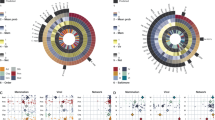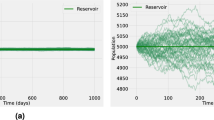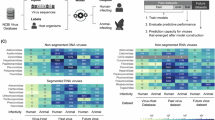Key Points
-
Zoonotic viruses pose a serious threat to human and animal health. Studying the immune response to zoonotic pathogens in the natural reservoir hosts, rather than traditional animal models, offers important insights into control strategies.
-
Comparative studies in natural host systems have provided key information and improved our understanding of co-evolution of hosts and pathogens. This could lead to the discovery of novel immune mechanisms that control viral replication.
-
Understanding the differences between the immune systems of domesticated and wild animal hosts and comparing them to the human immune system is crucial for unravelling the complex disease mechanisms involved in zoonotic infections and for developing new strategies for disrupting their transmission to humans.
-
The use of non-traditional animal models for research poses many challenges. These include the need for specialist high-biosecurity containment facilities, a lack of species-specific reagents for immunology studies, and complex husbandry, ethics and welfare issues.
-
Whole-genome sequencing and comparative analysis of host species have provided key insights into how different immune responses are made to the same pathogen.
-
The identification of key differences in immune pathways between susceptible and non-susceptible hosts might offer clues for developing disease intervention strategies, including new antiviral vaccines and therapies, and disease-resistant animals.
Abstract
Zoonotic viruses that emerge from wildlife and domesticated animals pose a serious threat to human and animal health. In many instances, mouse models have improved our understanding of the human immune response to infection; however, when dealing with emerging zoonotic diseases, they may be of limited use. This is particularly the case when the model fails to reproduce the disease status that is seen in the natural reservoir, transmission species or human host. In this Review, we discuss how researchers are placing more emphasis on the study of the immune response to zoonotic infections in the natural reservoir hosts and spillover species. Such studies will not only lead to a greater understanding of how these infections induce variable disease and immune responses in distinct species but also offer important insights into the evolution of mammalian immune systems.
This is a preview of subscription content, access via your institution
Access options
Subscribe to this journal
Receive 12 print issues and online access
$259.00 per year
only $21.58 per issue
Buy this article
- Purchase on SpringerLink
- Instant access to full article PDF
Prices may be subject to local taxes which are calculated during checkout




Similar content being viewed by others
References
Taylor, L. H., Latham, S. M. & Woolhouse, M. E. Risk factors for human disease emergence. Phil. Trans. R. Soc. Lond. B 356, 983–989 (2001).
Jones, K. E. et al. Global trends in emerging infectious diseases. Nature 451, 990–993 (2008). This article reviews the drivers of emerging disease and how they are linked to the species-specific and temporal patterns of outbreaks worldwide.
Legrand, N., Weijer, K. & Spits, H. Experimental models to study development and function of the human immune system in vivo. J. Immunol. 176, 2053–2058 (2006).
Cooper, M. D. & Herrin, B. R. How did our complex immune system evolve? Nature Rev. Immunol. 10, 2–3 (2010).
Medzhitov, R., Preston-Hurlburt, P. & Janeway, C. A. Jr. A human homologue of the Drosophila Toll protein signals activation of adaptive immunity. Nature 388, 394–397 (1997).
Fire, A. et al. Potent and specific genetic interference by double-stranded RNA in Caenorhabditis elegans. Nature 391, 806–811 (1998).
Li, J. et al. B lymphocytes from early vertebrates have potent phagocytic and microbicidal abilities. Nature Immunol. 7, 1116–1124 (2006).
Zhu, C. et al. Origin of immunoglobulin isotype switching. Curr. Biol. 22, 872–880 (2012).
Criscitiello, M. F., Saltis, M. & Flajnik, M. F. An evolutionarily mobile antigen receptor variable region gene: doubly rearranging NAR-TcR genes in sharks. Proc. Natl Acad. Sci. USA 103, 5036–5041 (2006).
Parra, Z. E. et al. A unique T cell receptor discovered in marsupials. Proc. Natl Acad. Sci. USA 104, 9776–9781 (2007).
Parra, Z. E., Ohta, Y., Criscitiello, M. F., Flajnik, M. F. & Miller, R. D. The dynamic TCRδ: TCRδ chains in the amphibian Xenopus tropicalis utilize antibody-like V genes. Eur. J. Immunol. 40, 2319–2329 (2010).
Hong, X. et al. Sugar-binding proteins from fish: selection of high affinity “lambodies” that recognize biomedically relevant glycans. ACS Chem. Biol. 8, 152–160 (2013).
Wang, L. F., Walker, P. J. & Poon, L. L. Mass extinctions, biodiversity and mitochondrial function: are bats 'special' as reservoirs for emerging viruses? Curr. Opin. Virol. 1, 649–657 (2011).
Seok, J. et al. Genomic responses in mouse models poorly mimic human inflammatory diseases. Proc. Natl Acad. Sci. USA 110, 3507–3512 (2013). This paper shows how results from mouse models sometimes correlate poorly with those in humans, using acute inflammatory responses as examples.
Suntharalingam, G. et al. Cytokine storm in a phase 1 trial of the anti-CD28 monoclonal antibody TGN1412. N. Engl. J. Med. 355, 1018–1028 (2006).
Benatar, M. Lost in translation: treatment trials in the SOD1 mouse and in human ALS. Neurobiol. Dis. 26, 1–13 (2007).
Tameris, M. D. et al. Safety and efficacy of MVA85A, a new tuberculosis vaccine, in infants previously vaccinated with BCG: a randomised, placebo-controlled phase 2b trial. Lancet 381, 1021–1028 (2013).
Mestas, J. & Hughes, C. C. Of mice and not men: differences between mouse and human immunology. J. Immunol. 172, 2731–2738 (2004). This paper highlights numerous key differences in the immune systems of mice and humans.
Hein, W. R. & Griebel, P. J. A road less travelled: large animal models in immunological research. Nature Rev. Immunol. 3, 79–84 (2003).
Le Douarin, N. M. & Dieterlen-Lievre, F. How studies on the avian embryo have opened new avenues in the understanding of development: a view about the neural and hematopoietic systems. Dev. Growth Differ. 55, 1–14 (2013).
Chen, C. L., Bucy, R. P. & Cooper, M. D. T cell differentiation in birds. Semin. Immunol. 2, 79–86 (1990).
Glick, B., Chang, T. S. & Jaap, G. The bursa of Fabricius and antibody production. Poult. Sci. 35, 224–225 (1956).
Isaacs, A. & Lindenmann, J. Virus interference. I. The interferon. Proc. R. Soc. Lond. B Biol. Sci. 147, 258–267 (1957).
Waters, W. R. et al. Tuberculosis immunity: opportunities from studies with cattle. Clin. Dev. Immunol. 2011, 768542 (2011).
Belser, J. A., Katz, J. M. & Tumpey, T. M. The ferret as a model organism to study influenza A virus infection. Dis. Model. Mech. 4, 575–579 (2011).
Menne, S. & Cote, P. J. The woodchuck as an animal model for pathogenesis and therapy of chronic hepatitis B virus infection. World J. Gastroenterol. 13, 104–124 (2007).
Belov, K. Contagious cancer: lessons from the devil and the dog. Bioessays 34, 285–292 (2012).
Clark, I. A. The advent of the cytokine storm. Immunol. Cell Biol. 85, 271–273 (2007). A review of the concept of cytokine storm and its potential role in disease pathogenesis.
Lee, N. et al. Hypercytokinemia and hyperactivation of phospho-p38 mitogen-activated protein kinase in severe human influenza A virus infection. Clin. Infect. Dis. 45, 723–731 (2007).
Karpala, A. J. et al. Highly pathogenic (H5N1) avian influenza induces an inflammatory T helper type 1 cytokine response in the chicken. J. Interferon Cytokine Res. 31, 393–400 (2011).
Tisoncik, J. R. et al. Into the eye of the cytokine storm. Microbiol. Mol. Biol. Rev. 76, 16–32 (2012).
Pantin-Jackwood, M. J. & Swayne, D. E. Pathobiology of Asian highly pathogenic avian influenza H5N1 virus infections in ducks. Avian Dis. 51, 250–259 (2007).
Mahalingam, S. et al. Hendra virus: an emerging paramyxovirus in Australia. Lancet Infect. Dis. 12, 799–807 (2012). A comprehensive review of the Hendra virus.
Huang da, W., Sherman, B. T. & Lempicki, R. A. Bioinformatics enrichment tools: paths toward the comprehensive functional analysis of large gene lists. Nucleic Acids Res. 37, 1–13 (2009).
Meliopoulos, V. A. et al. Host gene targets for novel influenza therapies elucidated by high-throughput RNA interference screens. FASEB J. 26, 1372–1386 (2012).
Zhang, G. et al. Comparative analysis of bat genomes provides insight into the evolution of flight and immunity. Science 339, 456–460 (2013). A detailed analysis and comparison of two bat genomes that provides interesting discussion on the link between evolution of flight and immunity.
Huang, Y. et al. The duck genome and transcriptome provide insight into an avian influenza virus reservoir species. Nature Genet. 45, 776–783 (2013).
The Bactrian Camels Genome Sequencing and Analysis Consortium. Genome sequences of wild and domestic bactrian camels. Nature Commun. 3, 1202 (2012).
Pontius, J. U. et al. Initial sequence and comparative analysis of the cat genome. Genome Res. 17, 1675–1689 (2007).
Luis, A. D. et al. A comparison of bats and rodents as reservoirs of zoonotic viruses: are bats special? Proc. Biol. Sci. 280, 20122753 (2013).
Papenfuss, A. T. et al. The immune gene repertoire of an important viral reservoir, the Australian black flying fox. BMC Genomics 13, 261 (2012).
Ferguson, B. J., Mansur, D. S., Peters, N. E., Ren, H. & Smith, G. L. DNA-PK is a DNA sensor for IRF-3-dependent innate immunity. Elife 1, e00047 (2012).
Baker, M. L., Schountz, T. & Wang, L. F. Antiviral immune responses of bats: a review. Zoonoses Publ. Health 60, 104–116 (2013).
Chahroudi, A., Bosinger, S. E., Vanderford, T. H., Paiardini, M. & Silvestri, G. Natural SIV hosts: showing AIDS the door. Science 335, 1188–1193 (2012).
Viney, M. E., Riley, E. M. & Buchanan, K. L. Optimal immune responses: immunocompetence revisited. Trends Ecol. Evol. 20, 665–669 (2005).
Schountz, T. et al. Regulatory T cell-like responses in deer mice persistently infected with Sin Nombre virus. Proc. Natl Acad. Sci. USA 104, 15496–15501 (2007).
Easterbrook, J. D. & Klein, S. L. Immunological mechanisms mediating hantavirus persistence in rodent reservoirs. PLoS Pathog. 4, e1000172 (2008).
Itoh, Y. et al. In vitro and in vivo characterization of new swine-origin H1N1 influenza viruses. Nature 460, 1021–1025 (2009).
Chowell, G. et al. Severe respiratory disease concurrent with the circulation of H1N1 influenza. N. Engl. J. Med. 361, 674–679 (2009).
Fisman, D. N. et al. Older age and a reduced likelihood of 2009 H1N1 virus infection. N. Engl. J. Med. 361, 2000–2001 (2009).
Chen, Y. et al. Human infections with the emerging avian influenza A H7N9 virus from wet market poultry: clinical analysis and characterisation of viral genome. Lancet 381, 1916–1925 (2013).
De Groot, A. S. et al. Low immunogenicity predicted for emerging avian-origin H7N9: Implication for influenza vaccine design. Hum. Vaccin. Immunother. 9, 950–956 (2013).
World Health Organization. Overview of the emergence and characteristics of the avian influenza A(H7N9) virus. World Health Organization [online], (2013).
Perdue, M. L. & Swayne, D. E. Public health risk from avian influenza viruses. Avian Dis. 49, 317–327 (2005).
Barber, M. R., Aldridge, J. R. Jr, Webster, R. G. & Magor, K. E. Association of RIG-I with innate immunity of ducks to influenza. Proc. Natl Acad. Sci. USA 107, 5913–5918 (2010).
Bedell, V. M. et al. In vivo genome editing using a high-efficiency TALEN system. Nature 491, 114–118 (2012).
Cong, L. et al. Multiplex genome engineering using CRISPR/Cas systems. Science 339, 819–823 (2013).
Cade, L. et al. Highly efficient generation of heritable zebrafish gene mutations using homo- and heterodimeric TALENs. Nucleic Acids Res. 40, 8001–8010 (2012).
Dahlem, T. J. et al. Simple methods for generating and detecting locus-specific mutations induced with TALENs in the zebrafish genome. PLoS Genet. 8, e1002861 (2012).
Hwang, W. Y. et al. Efficient genome editing in zebrafish using a CRISPR-Cas system. Nature Biotech. 31, 227–229 (2013).
Carbery, I. D. et al. Targeted genome modification in mice using zinc-finger nucleases. Genetics 186, 451–459 (2010).
Mashimo, T. et al. Generation of knockout rats with X-linked severe combined immunodeficiency (X-SCID) using zinc-finger nucleases. PLoS ONE 5, e8870 (2010).
Carlson, D. F. et al. Efficient TALEN-mediated gene knockout in livestock. Proc. Natl Acad. Sci. USA 109, 17382–17387 (2012).
Zaki, A. M., van Boheemen, S., Bestebroer, T. M., Osterhaus, A. D. & Fouchier, R. A. Isolation of a novel coronavirus from a man with pneumonia in Saudi Arabia. N. Engl. J. Med. 367, 1814–1820 (2012).
Yu, H. et al. Human infection with avian influenza A H7N9 virus: an assessment of clinical severity. Lancet 382, 138–145 (2013).
Relman, D. A., Hamburg, M. A., Choffnes, E. R. & Mack, A. in Microbial Evolution and Co-Adaptation: A Tribute to the Life and Scientific Legacies of Joshua Lederberg Ch. 5, 193–272 (National Academies Press, 2009).
Patz, J. A. et al. Unhealthy landscapes: policy recommendations on land use change and infectious disease emergence. Environ. Health Perspect. 112, 1092–1098 (2004).
Pulliam, J. R. et al. Agricultural intensification, priming for persistence and the emergence of Nipah virus: a lethal bat-borne zoonosis. J. R. Soc. Interface 9, 89–101 (2012).
Swenson, S. L. et al. Natural cases of 2009 pandemic H1N1 Influenza A virus in pet ferrets. J. Vet. Diagn. Invest. 22, 784–788 (2010).
Reperant, L. A., Kuiken, T. & Osterhaus, A. D. Influenza viruses: from birds to humans. Hum. Vaccin Immunother. 8, 7–16 (2012). A comprehensive, updated review of cross-species transmission of avian inflenza viruses.
Tong, S. et al. A distinct lineage of influenza A virus from bats. Proc. Natl Acad. Sci. USA 109, 4269–4274 (2012).
Shi, Z. & Hu, Z. A review of studies on animal reservoirs of the SARS coronavirus. Virus Res. 133, 74–87 (2008).
Carver, S., Bestall, A., Jardine, A. & Ostfeld, R. S. Influence of hosts on the ecology of arboviral transmission: potential mechanisms influencing dengue, Murray Valley encephalitis, and Ross River virus in Australia. Vector Borne Zoonot. Dis. 9, 51–64 (2009).
Clayton, B. A., Wang, L. F. & Marsh, G. A. Henipaviruses: an updated review focusing on the pteropid reservoir and features of transmission. Zoonoses Publ. Health 60, 69–83 (2013).
Rupprecht, C. E., Turmelle, A. & Kuzmin, I. V. A perspective on lyssavirus emergence and perpetuation. Curr. Opin. Virol. 1, 662–670 (2011).
Hatz, C. F., Kuenzli, E. & Funk, M. Rabies: relevance, prevention, and management in travel medicine. Infect. Dis. Clin. North Am. 26, 739–753 (2012).
Kay, B. H., Boyd, A. M., Ryan, P. A. & Hall, R. A. Mosquito feeding patterns and natural infection of vertebrates with Ross River and Barmah Forest viruses in Brisbane, Australia. Am. J. Trop. Med. Hyg. 76, 417–423 (2007).
Tong, S. et al. Climate variability, social and environmental factors, and Ross River virus transmission: research development and future research needs. Environ. Health Perspect. 116, 1591–1597 (2008).
Author information
Authors and Affiliations
Corresponding author
Ethics declarations
Competing interests
The authors declare no competing financial interests.
Related links
FURTHER INFORMATION
Supplementary information
Supplementary information S1 (table)
Natural reservoir hosts and susceptible hosts involved in transmission of bacterial, prion, parasitic and other viral zoonotic diseases (PDF 167 kb)
Glossary
- Variable lymphocyte receptors
-
Alternative forms of somatically diversified antigen receptors expressed by lymphocytes of jawless vertebrates. The combinatorial diversity of these receptors is based on variable numbers of leucine-rich repeat elements assembled by a gene-conversion process.
- Bursa of Fabricius
-
A primary lymphoid organ that is only found in birds. B cells mature in this organ, and indeed were first observed and named after this site: the 'B' in B cell refers to 'bursa-derived'.
Rights and permissions
About this article
Cite this article
Bean, A., Baker, M., Stewart, C. et al. Studying immunity to zoonotic diseases in the natural host — keeping it real. Nat Rev Immunol 13, 851–861 (2013). https://doi.org/10.1038/nri3551
Published:
Issue date:
DOI: https://doi.org/10.1038/nri3551
This article is cited by
-
COVID-19 highlights the model dilemma in biomedical research
Nature Reviews Materials (2021)
-
Using cross-species vaccination approaches to counter emerging infectious diseases
Nature Reviews Immunology (2021)
-
Robust dengue virus infection in bat cells and limited innate immune responses coupled with positive serology from bats in IndoMalaya and Australasia
Cellular and Molecular Life Sciences (2020)
-
Preclinical septic shock research: why we need an animal ICU
Annals of Intensive Care (2019)
-
Bat lung epithelial cells show greater host species-specific innate resistance than MDCK cells to human and avian influenza viruses
Virology Journal (2018)



